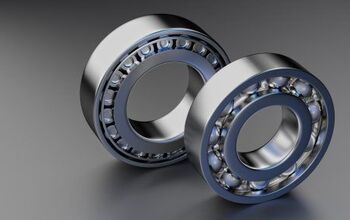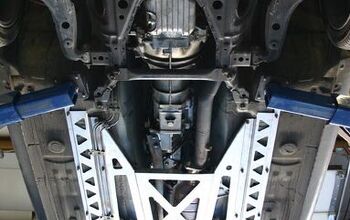Piston Slap: An Air Filtration Fallacy?

Dear Sajeev,
I can remember many times where I’d hear, in passing, someone say that K&Ns and other performance air filters were actually bad for my car… daily or otherwise. Their argument was always that the performance filters allowed that 1 percent of dirt to get through. This argument came up again as Engineering Explained did an air filter comparison. His tests showed a small increase in power at a very minor risk of extra dirt (which seems to be less than 1 percent in many cases).
My question is: If an engine is an air pump and you’re filtering the majority of the dirty out, who cares about the 1 percent that gets through and enters the combustion chamber? When was the last time you heard of an engine dying due to dirty air?
Sajeev answers:
Even in my years monitoring the performance of half-dead hoopties (that often run K&Ns, FWIW) as a 24 Hours of Lemons judge, I’ve never heard of engine failure via air filtration issues.
Much less seen verification of it!
While the extra 4 hp in a whipplecharged Ford GT (backstory here) is meaningless, the K&Ns had zero adverse effect after thousands of miles. More to the point, considering the reputation and warranty of Underground Racing’s twin turbo kits, odds are cotton gauze filters do an adequate job for extreme use… Lemons racing or otherwise.
But what about normal stuff? The K&N (purchased in 1998) for my first Lincoln Mark VIII (reused for my second, 2003 purchase) met my expectations because it:
- Has 150,000+ collective miles with no signs of wear.
- Filters almost everything: upon doing a resonator delete in 2010(?), the tube was almost as clean as this video.
- Burns zero oil between 8,000-ish mile intervals, no signs of blow by, and has plenty of compression: running hard enough to hang with modern performance cars (until they destroy me with their 6-10 speed gearboxes).
As the tests in the video above suggest, I doubt paper air filters do a significantly better job. But what keeps me a cotton gauze loyalist is:
- The unbelievably vague promise that meaningful upgrades (computer re-flash, forced induction, etc.) benefit further from that 4-ish HP boost.
- The “throatier” intake sound, especially after removing intake resonators/silencers installed to meet (conformist) consumer expectations and/or possible EPA noise requirements. The latter might be why Active Sound Systems are a thing, but this mod won’t attract attention if you’re modest with throttle input around pedestrians/law enforcement.
- Most importantly, they seemingly last forever: comforting for a vehicle that will remain for the life of the owner.
Bonus! A Piston Slap Nugget of Wisdom!
Let’s talk about a cotton gauze air filter’s oil causing problems with a MAF sensor, which is clearly a sore spot for the manufacturers considering this link. And if this link is true, the quote of the “2,500,000 filters K&N sells a year, they encounter less than 200 dealership problems annually” is a good indication that YOU haven’t seen fouled MAF sensors either.
Send your queries to sajeev@thetruthaboutcars.com. Spare no details and ask for a speedy resolution if you’re in a hurry…but be realistic, and use your make/model specific forums instead of TTAC for more timely advice.
[Image: OP]

More by Sajeev Mehta
Latest Car Reviews
Read moreLatest Product Reviews
Read moreRecent Comments
- Teddyc73 "eye-searingly"?
- Teddyc73 I applaud anyone who purchases a vibrant, distinct or less popular color. We need these people. Our road ways have turned into a dreary gloomy sea of white, black, silver and greys, most with the equally lifeless black wheels. Mr Healey is guilty of contributing to this gloom apparently. It looks like a black and white movie across the nation when grouped with our grey houses with grey interiors. Totally dull and lifeless. And what is with this awful hideous trend of dull grey with black wheels showing up everywhere? It's on everything. Just awful. Come on people! I'll keep my Ram 1500 with it's deep rich sparkling Western Brown paint as long as I can.
- Shipwright As my Avatar shows I had an '08 GT 500, Grabber Orange convertible. I now own a '12 GT 500 Kona Blue coupe.
- ArialATOMV8 I tend to prefer more amusing colors when picking out a car (if possible). My 2017 Lexus RX is painted in a Nightfall Mica (Dark Blue) and I really dig the look. In the dealership it stands out compared to the regular tame blacks, silvers and whites. Soon I may be at the point to afford a new car and when I do, I'll do my part and spec/hunt for an allocation of a vibrant color.
- Tassos Tim is not that good with colors.The bright "pink" is not pink, but FUCHSIA. Both colors may look good on a woman's sweater, but not on steel panels.


































Comments
Join the conversation
After using K&N filters for years, I made the switch to AEM Dryflow filters. No more oiling - all you do is wash (with air filter cleaner), rinse and dry. Comparing the two reveals that the AEM feels more solidly constructed (especially the seal) than the K&N.
I've got three-quarters of a $20 cleaning kit left over from the $90 filter I justed traded away in my previous motorcycle, for anyone who wants to "save money" like I did. Let's face it, the real purpose of a K&N filter is to give yourself an excuse to spend more time in the garage.